It’s All About the Energy – Measuring Radiation
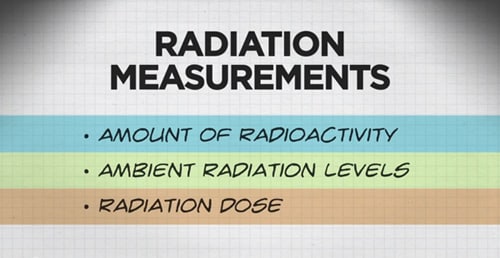
If you encounter radiation units or measurements that you don’t understand, the best thing to do is to ask a radiation safety professional for assistance. These people work with radiation daily and can help you interpret measurements and put them into perspective.
When working with radiation, we are concerned about the amount of energy the material is emitting. The size, weight, and volume of the source don’t necessarily matter.
Depending on the radionuclide, a small amount of radioactive material may give off a lot of radiation.
On the other hand, a large amount of radioactive material may give off a small amount of radiation.
The three common measurements of radiation are the:
Amount of Radioactivity
For example, imagine we had a jar filled with radioactive material. We want to find out how many radioactive atoms decay every second, giving off alpha particles, beta particles, or gamma rays. This type of measurement is the amount of radioactivity in the jar. For more information, click below.
We measure the amount of radioactivity by finding out how many radioactive atoms decay every second. These atoms may be giving off alpha particles, beta particles, and/or gamma rays.
Units for Amount of Radioactivity
To report the amount of radioactivity, we use either:
- the international unit for activity, the Becquerel (Bq)
- the United States unit for activity, the Curie (Ci)
These units measure the same thing, but they are based on different scales. The Becquerel is based on the number of disintegrations, or radioactive decays, per second. This is the unit used today in most of the world.
In the United States, some people still use the older unit or Curie. The Curie was based on the activity of one gram of radium, so one Curie ends up being much larger than one Becquerel.
1 Ci = 37 billion Bq; so converting between the international and U.S. units can be challenging.
It’s also common to see activity reported in units like:
- microCuries (uCi)
- picoCuries (pCi)
- megaBecqurel (MBq)
- gigaBecquerel (GBq)
Instruments for Measuring the Amount of Radioactivity
We have some portable instruments that are intended for detecting contamination on a person or an object.
A Geiger-Mueller counter is one good example. This type of detector is common, but there are other similar products.
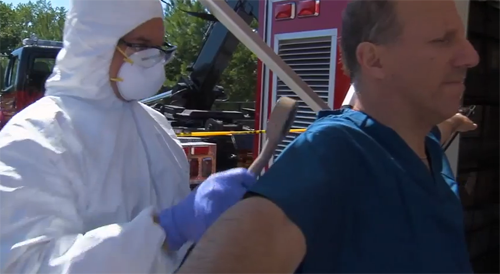
Another device we can use is a portal monitor.
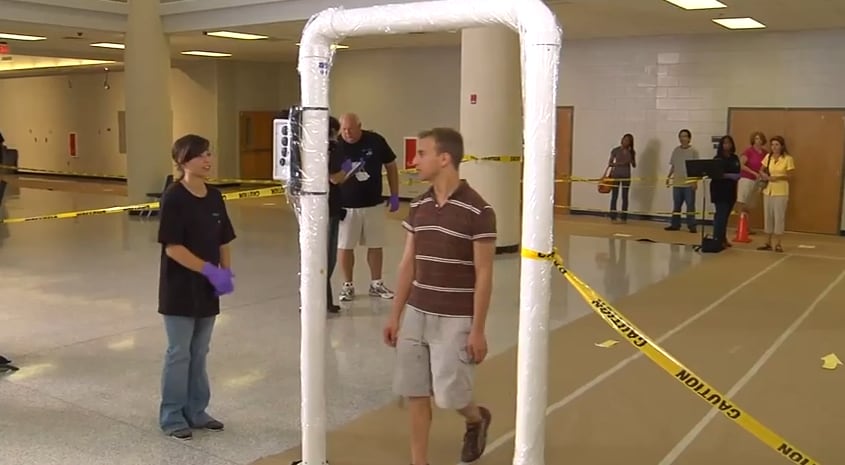
This is useful for screening large numbers of people for contamination. Like the metal detectors at an airport, people just walk through them and if they are contaminated with radioactive material, the portal will alarm. Portal monitors can only detect gamma radiation and some forms of beta radiation.
Specialized laboratory equipment can also be used to detect radioactivity in environmental samples or clinical samples from people. These instruments are extremely sensitive and can measure very small amounts of radiation.
Ambient Radiation Levels
We also want to find out how much of the radiation from the material in the jar actually makes it to any given location. This type of measurement will give us the ambient radiation levels at this location. For more information, click below.
Ambient radiation levels measure how much radiation is in the environment around us.
For example, if we had a jar filled with radioactive material, we may want to know how much of the radiation from the material in the jar actually makes it to any given location.
Some of this will be background radiation from radionuclides already in the environment.
If the material in this jar gives off only alpha particles, we won’t be able to measure anything outside of the jar because alpha particles cannot go through the glass.
But, if this material gave off gamma rays instead of alpha particles, the jar wouldn’t shield the gamma rays. This would add to the ambient radiation levels in the room.
Units for Ambient Radiation Levels
To report the ambient radiation levels we can use international units:
- Gray per hour (Gy/h)
- Sievert per hour (Sv/h)
Or, in the United States, you may see ambient radiation levels reported in:
- Roentgen per hour (R/h)
- rem per hour (rem/h)
It is also common to see variations on these units, like:
- nanoGray per hour (nGy/h)
- microSieverts per hour (uSv/h)
- microRoentgen (uR/h) per hour
- millirem per hour (mrem/h)
An easy way to convert between the U.S. and international units is to multiply the international readings by 100. For example, 1 Sv/h = 100 rem/h.
Instruments for Measuring Ambient Radiation Levels
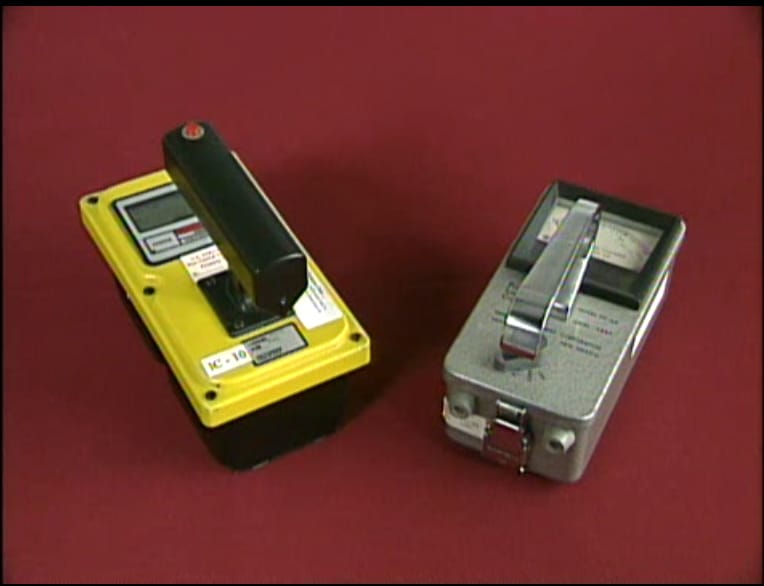
Radiation Dose
Finally, we are especially interested to know how much radiation is absorbed by the body while standing next to this jar. This type of measurement tells us the radiation dose. For more information, click below.
Radiation dose is the amount of radiation absorbed by the body.
If we know the ambient radiation level, we easily can calculate our radiation dose. Imagine the ambient radiation levels coming from this jar where this person is standing are 0.5 Sv/h. If this person stands in the same place for one hour, he will receive a dose of 0.5 Sieverts.
But, if he moves away from the jar, the ambient radiation levels will drop, and so will his dose. Putting distance between yourself and radioactive material is a key principle of radiation safety.
Units for Measuring Radiation Dose
To report the radiation dose, we use either:
- the international unit for dose, the Sievert (Sv) or the Gray (Gy)
- the United States unit for dose, the rem or the rad
It is common to see variations of these units such as:
- millisievert (mSv)
- millirem (mrem)
Converting between international units and U.S. units is easy for dose:
- 1 Sv = 100 rem
- 1rem = 10 mSv
- 1 Gy = 100 rad
- 1 rad = 10 mGy
For more information on how to convert between international and U.S. units, click here. (external)
Instruments for Measuring Radiation Dose
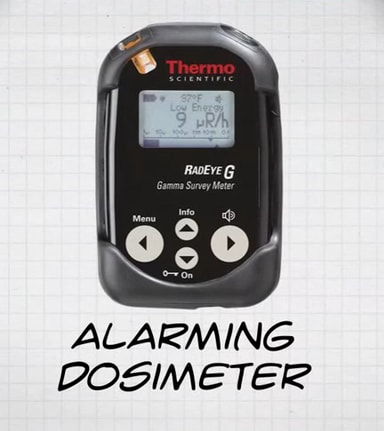
You may notice that some people that work in places that routinely use radiation (such as in hospitals) wear a dosimeter that does not alarm, such as the one shown below. These dosimeters are worn to make sure they comply with the regulatory dose limits for radiation workers.
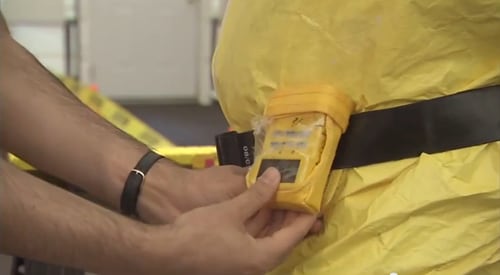
There are also specialized instruments for measuring a dose received through internal contamination. Hospitals can use these instruments to measure the amount of radioactivity administered to nuclear medicine patients.
Putting Radiation Dose in Perspective
The average dose we receive every year, just from living on Earth, is approximately 3 mSv. About two-thirds of that dose comes from radon, a gas that occurs naturally from the breakdown of uranium.
Medical procedures add another 3 mSv, on average, bringing the total annual exposure for the average person to slightly more than 6 mSv. But, as individuals, the radiation doses we may receive in any one year can vary quite a bit.
There are many things that can influence our radiation dose in any year:
Some types of radiation, like natural background radiation, are present all the time and provide a continuous dose that accumulates over time. This natural background depends on a number of factors. For example:
- If you live at higher elevation, you receive a higher dose of cosmic radiation.
- If you share a bed with your spouse or partner, you each get a small dose of radiation from the naturally occurring radioactive potassium-40 in each other’s body. You irradiate each other during the night.
- You may live in a home that has elevated radon levels.
Medical imaging procedures used in diagnostic exams such as x-rays and CT scans provide a one-time dose – you receive the radiation during the test and that’s it. Other medical procedures, such as nuclear medicine, may involve giving you a small amount of radioactive material to assist in imaging. In that case, you will emit radiation for up to several days after the exam. The frequency of activities such as medical procedures that provide one-time doses will impact your annual radiation dose.
This does not mean that medical procedures like CT scans are harmful. The dose you receive from these and other medical procedures comes with a benefit – the imaging helps doctors make a diagnosis. But it is important to consider the risks and benefits of any procedure or activity that exposes you to ionizing radiation.
For more information on measuring radiation dose, click here